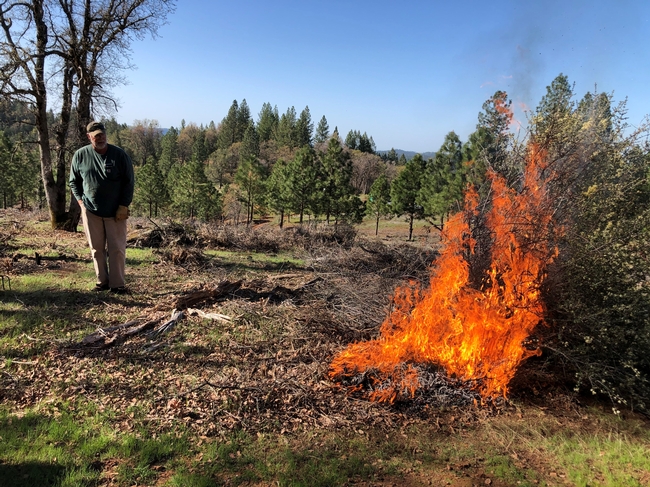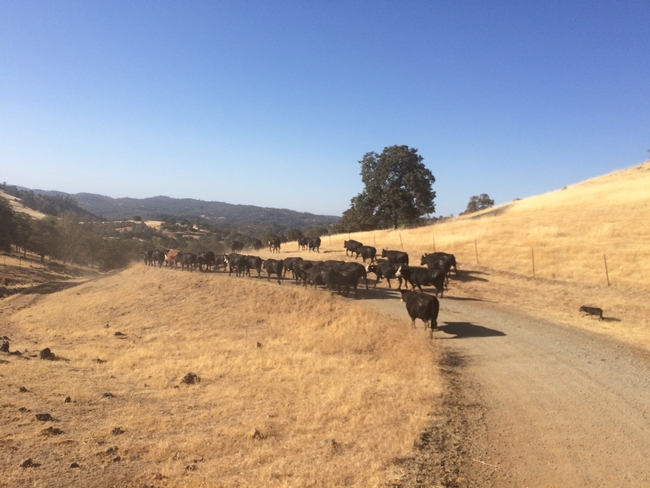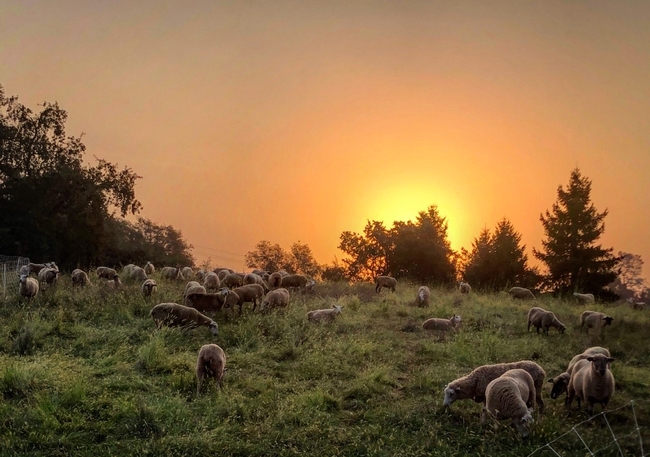Late last month, we held a Prescribed Fire on Working Landscapes workshop near Colfax, culminating in a small broadcast burn on the Edwards Family Tree Farm. As we prepared to ignite the burn, our instructor emphasized that the dry winter and early spring had resulted in fire conditions that were more like early June than late March. Last night, after I finished working in the office, I decided to try to burn some brush at our home place near Auburn. The message on the Placer County Burn Information line indicated that burning was suspended through tomorrow due to elevated fire danger. In early April. I guess it's time to start preparing our ranches for another fire season.
Wildfire preparations can more complicated for commercial livestock operations than for typical homeowners. In addition to creating a fire-safe space around homes, we also need to protect livestock and ranch infrastructure. Many ranches have livestock in multiple locations, and many of these leased pastures are simply pastures; there is no landlord or caretaker on site. Often, the number of livestock at a particular location may be more than can be easily evacuated in case of wildfire. Finally, access during a fire may be difficult due to law enforcement road blocks and priority for fire equipment. Here are a few of things we do to get ready for fire season.
Assessing the Threat
What is at risk in our operation? Do we have livestock in multiple locations? What is access like? At a minimum, our wildfire preparation efforts address the following:
- Create defensible space around home(s), barns and other infrastructure.
- Are there any access issues at any location where you have livestock? Single lane roads can be especially problematic. Do you have alternative access points?
- If you rely on dry forage for fall grazing, are there steps you can take to protect this forage from fire?
- Are there potential animal health issues associated with smoke and other indirect wildfire impacts?
Developing and Implementing a Wildfire Plan
Our ranch wildfire plan has several components:
- Protecting buildings, infrastructure and information: We remove flammable vegetation from within 100 feet of houses and other buildings. This also includes other critical infrastructure like propane tanks, wells, equipment sheds, barns and corrals. We also make sure we have protected critical legal documents and insurance information. Check CalFire's suggestions for putting together an emergency supply kit (http://www.readyforwildfire.org/Emergency-Supply-Kit/).
- Protecting forage: Like many operations, we stock our rangeland pastures conservatively to ensure a supply of fall forage. In some areas, we try to create fuel breaks to protect this forage from wildfire through targeted grazing. Disking or grading around the perimeter of pastures, or at least adjacent to potential ignition sources, can also reduce the threat. The width of any fuel break depends on the fuel type, topography/slope, and potential flame lengths that a fire might generate.
- Protecting livestock: We try to plan ahead for how we might move livestock out of harm's way in the event of a wildfire. That said, we have too many animals to evacuate on short notice; leaving animals in pasture (or “sheltering in place”) might be our best option. Fortunately, we've never had to do this. If you need to leave animals in place, be sure they have enough feed and water for several days. Will the livestock have water if the power goes out? Be sure to take down temporary fences or other hazards that may injure livestock as the fire moves through the property. Prepare for any post-fire health problems (like respiratory infections or other injuries) as well.
- Water supply: Water is critical for protecting our properties and for keeping livestock healthy. Do you have adequate water supplies for wetting down your buildings and facilities, or for directly fighting fire? If you have to pump water, do you have a backup system in case you lose power? Can you provide stock water if the power goes out? You may want to consider investing in a backup generator and/or additional water storage.
- Escape routes: Ideally, we try to have at least two routes in and out of our ranch properties. In addition, we try to think about at least two alternatives for moving livestock to safety in the event of a fire - this means loading and unloading facilities, a plan for gathering livestock, and a clear understanding of the road system near your pastures. Narrow roads can be problematic for navigating with stock trailers, especially when fire equipment is also inbound.
- Backup: Obviously, many of us can't be on hand 24 hours a day, seven days a week to respond to a fast-moving fire (especially when livestock are grazing on multiple properties). We work with friends, neighbors or colleagues to have a backup plan to evacuate or otherwise protect your livestock. Consider meeting with your neighbors to go over key livestock facilities, evacuation plans and access routes. Be sure to check in with these backup resources in the event of fire.
- Communication plans: I try to keep phone numbers for the other ranchers in our area on my phone, and I try to keep track of who runs the cows or sheep next door. During fire season, many ranchers text or call neighbors when they see smoke. Consider formalizing these calling trees.
- Situational awareness: During fire season, I constantly watch for smoke, especially when I hear fire equipment or aircraft. We carry a shovel or other fire tool and 5 gallons of water in our pickups and pay attention to where ranch visitors park – a catalytic converter on dry grass can be disastrous. I also check local news websites or alert services (like www.yubanet.com).
Writing Down our Plan
Even for ranching operations with few or no employees, writing down our plan can help others (spouses, neighbors, etc.) know what to do and who to contact in case of fire. Our written plan includes the locations where livestock are grazing (which suggests this plan needs to be updated as livestock are moved). Location information includes a physical address and/or map, along with the number and class of animals on site. We also include a description of potential evacuation routes (including locations of loading facilities). Are there safe zones (like dry lots or irrigated pastures) on the property or nearby where animals could be moved if evacuation isn't possible? Is there an onsite caretaker or neighbor we can call in case of emergency? Are there other ranchers who could help us? What are the numbers of livestock haulers who might be available? Click here for a template for completing your own plan!
I share a copy of this plan with other people in our operation – specifically, with my wife and kids, and my partner. This year, I'll plan on sharing this plan with our landlords, as well. Finally, we'll provide a copy (or at least a list of locations where we have livestock) to our local fire, animal control, and law enforcement agencies.
A Future Solution?
As with many other ranching counties in California, Placer, Nevada, and Yuba Counties have been working on formalizing an Ag Pass program designed to help ranchers gain safe access to livestock in emergency situations. Assembly Member Megan Dahle has introduced legislation (AB 1103) that would implement this program statewide. These programs would require ranchers to attend training on fire behavior and the incident command system, and would likely also require a list of properties where livestock may be grazing. If you'd like more information about the Ag Pass idea, contact me at dmacon@ucanr.edu.
As I look back over previous posts to my Ranching in the Sierra Foothills blog, I see that I seem to write about wildfire preparation just about every spring. I guess that's the nature of living with fire - our ranch fire plans are something that we should revisit every year - better to have a plan that we don't use than to need a plan when fire strikes. Stay safe this summer!


